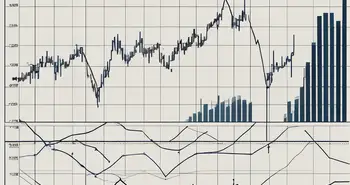Book-to-Market Ratio: How to Use This Metric to Find Undervalued Stocks

Uncovering stocks that are truly undervalued is one of the biggest challenges for investors, but there's a reliable tool that can help: the Book-to-Market Ratio. While flashy, high-priced stocks often steal the spotlight, this ratio helps shine a light on companies that may be overlooked by the market—those whose stock price doesn't reflect their actual worth.
In fact, stocks with a higher Book-to-Market Ratio have consistently delivered strong performance, making it a go-to metric for value investors. But what makes this ratio so effective, and how can it help you spot undervalued stocks? In this guide, we'll break down the Book-to-Market Ratio and show you how to use it to enhance your investment strategy.
The Concept of Book-to-Market Ratio
Definition of Book-to-Market Ratio
The Book-to-Market ratio (B/M ratio) is a financial metric that compares a company's book value (the value of its assets minus its liabilities) to its market value (the total value of its outstanding shares). This ratio serves as a measure of how much investors are willing to pay for a company's equity relative to what it is actually worth on paper. A higher B/M ratio suggests that a stock may be undervalued, as it indicates that the market’s valuation is less than the company’s net asset value.
To calculate the B/M ratio, you use the formula:
Book-to-Market Ratio = Book Value per Share / Market Value per Share
This metric helps investors identify potentially undervalued stocks that could offer substantial returns if the market adjusts to reflect their true value. Moreover, the B/M ratio can also serve as a barometer for assessing market sentiment. When the ratio is high, it may indicate a lack of investor confidence in the company's future prospects, leading to a lower market valuation. Conversely, a low B/M ratio might suggest that investors are optimistic about a company's growth potential, often resulting in a higher market price relative to its book value.
Importance of Book-to-Market Ratio in Stock Evaluation
The Book-to-Market ratio plays a crucial role in investment analysis as it helps investors ascertain the relative value of stocks. A high Book-to-Market ratio can signal to investors that a particular stock has been oversold and may present a buying opportunity. This is especially valuable in volatile markets where emotions may drive stock prices away from fundamentals.
From personal experience, I've seen situations where stocks with high B/M ratios later provided exceptional returns as the market corrected itself. One such instance involved a company in the tech sector, which, due to broader market panic, showed a B/M ratio far exceeding its historical norm. Investing at that moment turned out to be extremely rewarding when the stock eventually rebounded. Thus, employing the B/M ratio is essential for informed decision-making in stock selection. Additionally, the B/M ratio can be particularly useful when compared with other financial metrics, such as the Price-to-Earnings (P/E) ratio. By analyzing these ratios in conjunction, investors can gain a more comprehensive view of a company's valuation and its potential for future growth.
Furthermore, the B/M ratio is often employed in various investment strategies, including value investing, where investors seek out stocks that appear undervalued based on fundamental analysis. This approach relies heavily on the assumption that the market will eventually recognize and correct the disparity between a company's book value and its market price. As a result, many value investors keep a close eye on the B/M ratio as part of their stock screening process, looking for opportunities that align with their investment philosophy. Understanding how the B/M ratio interacts with market trends and economic cycles can also enhance an investor's ability to make strategic decisions in different market environments.
Calculating the Book-to-Market Ratio
Components of the Book-to-Market Ratio
Understanding the components that feed into the calculation of the B/M ratio is key to making informed investments. The two primary components are:
- Book Value per Share: This is derived from a company's financial statements, specifically the balance sheet. It is calculated by dividing the total shareholders’ equity by the number of outstanding shares.
- Market Value per Share: This is simply the current trading price of a company's stock. You can find this information on any stock market platform.
Step-by-Step Calculation Process
To calculate the Book-to-Market ratio, follow these easy steps:
- Find the total shareholders’ equity from the company's balance sheet.
- Divide this figure by the total number of outstanding shares to arrive at the Book Value per Share.
- Look up the current market price of the stock to determine the Market Value per Share.
- Finally, apply the B/M formula: Book Value per Share divided by Market Value per Share.
By diligently performing this calculation, investors can equip themselves with valuable insight into a stock's potential value relative to its price.
Moreover, the Book-to-Market ratio is particularly useful in identifying undervalued stocks. A high B/M ratio may indicate that a stock is trading at a price lower than its intrinsic value, suggesting a potential buying opportunity. Conversely, a low B/M ratio might signal that a stock is overvalued or that investors have high expectations for future growth, which may not always materialize. This makes the B/M ratio a critical tool for value investors who are looking to capitalize on market inefficiencies.
Additionally, it is important to consider the context in which the B/M ratio is applied. Different industries have varying norms for B/M ratios, influenced by factors such as growth prospects and capital structure. For instance, technology companies often exhibit lower B/M ratios due to their growth potential, while utility companies may have higher ratios reflecting their stable earnings and lower growth expectations. Thus, comparing the B/M ratio of a company to its industry peers can provide deeper insights into its relative valuation and investment attractiveness.
Interpreting the Book-to-Market Ratio
What a High Ratio Indicates
A high Book-to-Market ratio can be interpreted in several ways. Primarily, it signifies that the stock may be undervalued compared to its book value. This could signal an opportunity for savvy investors looking to capitalize on perceived market inefficiencies.
However, while a high ratio often attracts the attention of value investors, it is essential to dig deeper. A persistently high B/M could indicate underlying issues with the company’s business model or even structural industry challenges that legitimize the discounts the market places on its valuation. For instance, companies in declining industries may exhibit high B/M ratios due to stagnant earnings or negative growth projections, which could deter potential investors despite the attractive valuation metrics.
Furthermore, it's crucial to consider the context of the industry in which the company operates. Certain sectors, like technology, may naturally exhibit lower B/M ratios due to high growth expectations, while traditional industries like manufacturing might have higher ratios. Therefore, understanding the competitive landscape and the specific factors influencing a company's performance can provide valuable insights that go beyond the numbers.
What a Low Ratio Indicates
Conversely, a low Book-to-Market ratio suggests that the stock is overvalued relative to its book value. This might indicate strong investor confidence in the company’s future growth prospects, but it also introduces significant risk if the company fails to meet these expectations.
Finding a balance between high and low ratios while considering other performance metrics offers a more rounded view of the stock's potential. Thus, I advise keeping an eye on trends in B/M ratios across the sector you're interested in. Additionally, examining the company's earnings growth, cash flow, and return on equity can provide further clarity on whether a low B/M ratio is justified or if it presents a buying opportunity. Investors should also be wary of market sentiment, as overly optimistic projections can lead to inflated stock prices that may not be sustainable in the long run.
Using Book-to-Market Ratio to Identify Undervalued Stocks
Spotting Potential Investment Opportunities
The practical application of the Book-to-Market ratio lies in its ability to identify potential investment opportunities. Investors often screen for stocks with high B/M ratios as a starting point for their analysis. This step is particularly beneficial in sectors that have suffered recent downturns, as these stocks may possess the potential for recovery.
Moreover, coupling B/M analysis with other valuation metrics, such as Price-to-Earnings ratios or dividend yields, can provide a comprehensive understanding of the stock's true worth.
Risks Associated with High Book-to-Market Ratio Stocks
While high B/M stocks may seem like attractive investment candidates, it's important to remain cautious. Such stocks can sometimes be value traps, where the high ratio is a reflection of fundamental problems within the company rather than a true undervaluation.
For example, a stock that appears undervalued due to a high B/M ratio may be losing market share or facing increased competition, making it less of a bargain than it seems. As an investor, it's vital to perform thorough due diligence beyond just the B/M ratio.
Limitations of the Book-to-Market Ratio
Factors that Can Distort the Ratio
Despite its usefulness, the Book-to-Market ratio is not without limitations. A company with tangible assets, such as real estate firms or those in manufacturing, may exhibit higher B/M ratios, whereas tech firms with significant intangible assets may show artificially low ratios. This can obstruct meaningful comparisons across different sectors.
Additionally, companies in certain industries may experience drastic shifts in their market or book values, further complicating accurate assessments. Therefore, it’s imperative for investors to consider industry context when using the B/M ratio.
When Not to Rely on the Book-to-Market Ratio
In some scenarios, relying solely on the Book-to-Market ratio is ill-advised. A high ratio may not account for future growth prospects or potential market dynamics that could affect the stock price. Therefore, it’s beneficial to blend this ratio with a broader analytical framework, including qualitative factors, to arrive at more informed investment decisions.
FAQs
What is the Book-to-Market ratio and why is it important?
The Book-to-Market ratio compares a company's book value to its market value, helping investors identify potentially undervalued stocks. It is significant as it indicates how much investors are willing to pay for a stock compared to its intrinsic value.
How do I calculate the Book-to-Market ratio?
To calculate the B/M ratio, divide the Book Value per Share (total equity divided by outstanding shares) by the Market Value per Share (current stock price).
What does a high B/M ratio indicate?
A high Book-to-Market ratio suggests a stock may be undervalued and worth purchasing, but it should be analyzed further to eliminate the risk of value traps.
Are there risks in investing in high B/M ratio stocks?
Yes, high B/M stocks can sometimes become value traps if they are undervalued due to serious underlying business issues. Conduct thorough research before making investment decisions.
Ready to put your knowledge of the Book-to-Market ratio into action and discover undervalued stocks with the potential for high returns? Look no further than Morpher, the revolutionary trading platform that empowers you to trade stocks, cryptocurrencies, forex, and more with zero fees and infinite liquidity. With Morpher, you can start investing with as little as $1, take advantage of 10x leverage, and enjoy the safety of a non-custodial wallet. Embrace the future of trading on the blockchain and Sign Up and Get Your Free Sign Up Bonus today to transform your investment strategy!


Painless trading for everyone
Hundreds of markets all in one place - Apple, Bitcoin, Gold, Watches, NFTs, Sneakers and so much more.

Painless trading for everyone
Hundreds of markets all in one place - Apple, Bitcoin, Gold, Watches, NFTs, Sneakers and so much more.









